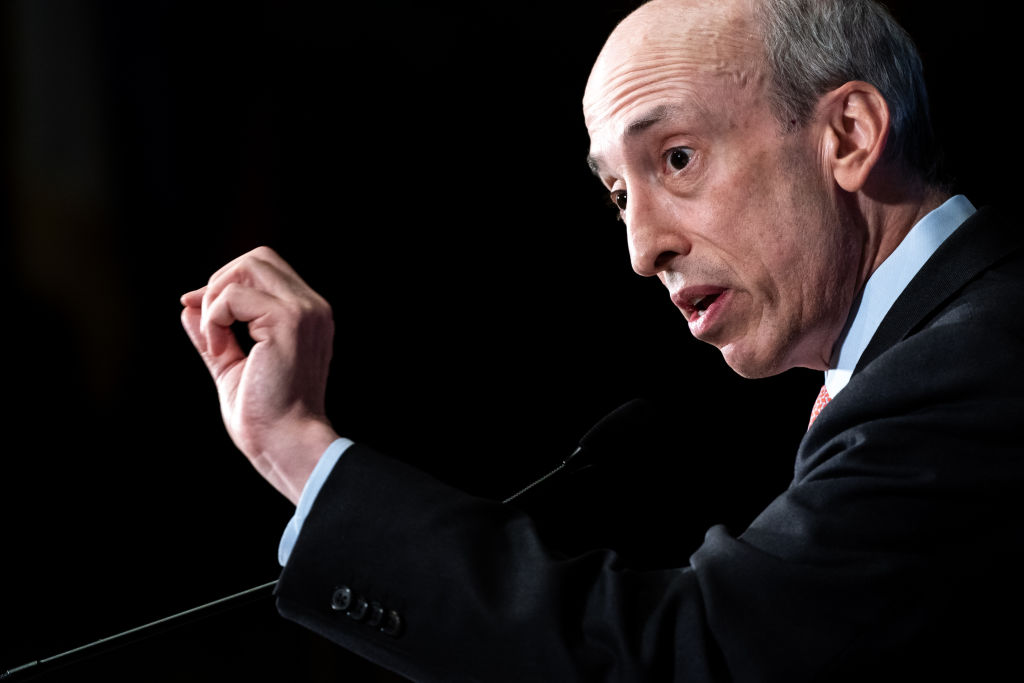
For nearly a century, the U.S. Securities and Exchange Commission (SEC) has wielded largely un-checked power over investment mechanics and capital formation. But federal courts are quietly poised to change that. While SEC Chairman Gary Gensler continues to try to broaden his agency's purview, pending federal cases—including two now before the Supreme Court—threaten to existentially diminish the SEC's power, just as the complexities of modern markets reach new heights.
In November, the Supreme Court held oral argument inSEC v. Jarkesy. The case deals with whether the agency's adjudication of fraud claims using its own administrative law judges deprives individuals of their Seventh Amendment right to a jury trial. The justices were all somewhat aligned in skepticism against the SEC’s in-house enforcement practice, with Chief Justice John Roberts coming close to questioning whether the very existence of the SEC enforcement tribunal serves to undermine the Seventh Amendment. That doesn’t bode well for the agency.
A loss in Jarkesy would force the SEC out of its own backyard and into federal court more frequently—a considerably more expensive, time-consuming, and uncertain enforcement process. And while Jarkesy directly threatens the SEC’s authority to enforce, another case on the Court’s docket—set for oral argument on Wednesday—threatens the agency’s basic ability to function as it pleases.
Loper Bright Enterprises v. Raimondo involves a 1976 law requiring fishing vessels to carry federal observers on board and, under certain conditions, pay those observers’ salaries. The National Marine Fisheries Service, a federal agency, decided in 2020 to interpret the law to require payment of those salaries even absent those conditions—an expansive interpretation that the D.C. Circuit Court of Appeals upheld as “reasonable” simply because the statute did not expressly preclude it. The D.C. Circuit relied on the Supreme Court’s framework in Chevron v. Natural Resources Defense Council (1984), which requires courts to give broad deference to an agency’s “reasonable” interpretation of an arguably ambiguous statute. In Loper Bright, the justices will decide whether to do away with so-called “Chevron deference.”
More From TIME
The loss of Chevron deference would limit an agency’s ability to enhance its regulatory and enforcement power through broadly self-serving interpretations of the congressional statutes that govern the extent of their authority—a mechanism that any federal agency chair would want to keep in their toolbox, particularly when it comes to new technologies that might not be explicitly covered by pre-existing statutes. That consideration is especially relevant for Gensler, who is deeply embroiled in a two-front battle to establish his agency’s control over cryptocurrency—a sector in urgent need of regulation, as the FTX debacle demonstrated.
While Gensler contends with the Commodity Futures Trading Commission for primary authority to regulate this giant swath of the synthetic asset market, the SEC is also fighting a corresponding battle through lower federal courts, where conflicting decisions threaten to undermine the agency’s position, if not place cryptocurrency out of the agency’s reach altogether.
In July, the Manhattan federal district court found that the crypto token at issue in SEC v. Ripple Labs was not a security in and of itself—that it was a security at the time of its issuance to investors but was not when programmatically sold on exchanges or issued to executives via corporate grants. More recently, the district court denied the SEC’s motion to certify those findings for a speedy interlocutory appeal at the Second Circuit—an expedited appeal on key issues to be heard while the case remains before the district court. Much to the delight of crypto firms, it will therefore be some time before the Second Circuit weighs in on whether cryptocurrency is a traditional security theoretically susceptible to SEC regulation.
One might expect that a ruling from the nation's most prominent federal trial court would hold sway over other courts faced with similar questions, increasing the likelihood of more decisions that come out against SEC regulation of crypto tokens. But in a ruling issued just before the New Year, another judge of the same court sided with the SEC on substantially the same issue, and without so much as referring to the Ripple Labs decision. Regulation by litigation is, after all, an unpredictable strategy and likely an untenable one if the SEC hopes to continue to impose its administrative will.
The SEC has reached its administrative peak under Gensler, on track to finalize 63 new rules within his first four years as chair. Gensler’s previous two predecessors finalized a combined total of just 65. And Gensler has allowed an average public comment period of just 46 days per rule—a substantial decline from those predecessors’ allowances. Founded as a response to the market crash of 1929, the SEC’s increasingly proactive approach is thus at odds with its reactionary constitutional origins—but not necessarily with the regulatory needs of modern market and investment dynamics. That existential tension is coming to a judicial head at a potentially perilous time.
As Justice Neil Gorsuch remarked during November’s oral argument in Jarkesy, “this is not your grandfather’s SEC.” Indeed—Jarkesy, Loper Bright and proliferating crypto cases might just be the three horsemen of the modern SEC apocalypse. At a minimum, by eliminating the SEC’s in-house enforcement mechanism, ending Chevron deference, and complicating the agency’s cryptocurrency purview, federal courts would alter the course of the SEC’s regulatory regime. It remains to be seen whether that would be a good thing.
More Must-Reads from TIME
- Why Biden Dropped Out
- Ukraine’s Plan to Survive Trump
- The Rise of a New Kind of Parenting Guru
- The Chaos and Commotion of the RNC in Photos
- Why We All Have a Stake in Twisters’ Success
- 8 Eating Habits That Actually Improve Your Sleep
- Welcome to the Noah Lyles Olympics
- Get Our Paris Olympics Newsletter in Your Inbox
Contact us at letters@time.com